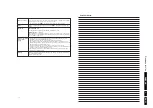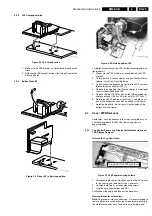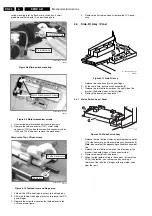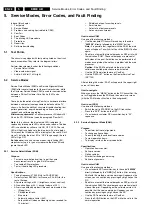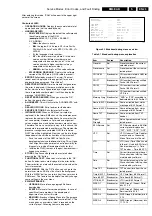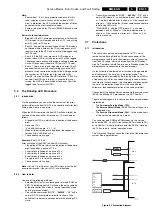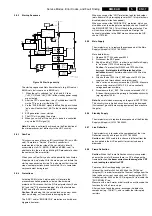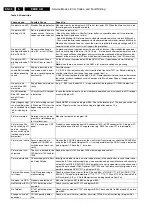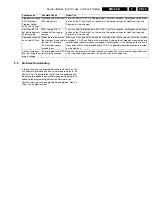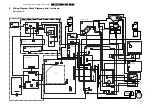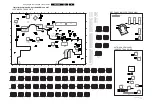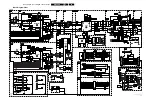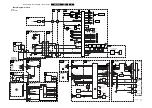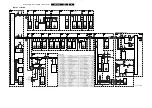
Service Modes, Error Codes, and Fault Finding
5.
There are several types of protections:
•
I
2
C related protections.
•
OTC related protections (via polling on I/O pins or via
algorithms).
•
HOP related protections (mainly for deflection items).
•
Hardware errors that are not sensed by the OTC (e.g.
vertical flyback protection, bridge coil protection, E/W
protection, arcing protection).
All protections are explained below.
5.7.2
I
2
C Related Protections
In normal operation, some registers of the I
2
C controlled ICs
are refreshed every 200 ms. During this sequence, the I
2
C
busses and the I
2
C ICs are checked.
An I
2
C protection will take place if the SDA and SCL lines are
short-circuited to ground, or to each other. An I
2
C error will also
occur, if the power supply of the IC is missing (e.g. FBX_PROT
(error 16)).
5.7.3
OTC Related Protections
If a protection is detected at an OTC input, the OTC will start to
scan all protection inputs every 200 ms for 5 times. If the
protection on one of the inputs is still active after 1 s, the
microprocessor will put the set in the protection mode. Before
the scanning is started, a so-called “ESD refresh” is carried out.
This is done, because the interrupt on one of the inputs is
possibly caused either by a flash or by ESD. As a flash or ESD
can influence IC settings, the HIP, MSP, 3D Comb (US only)
and wireless module are initialised again, to ensure the normal
picture and sound conditions of the set.
8 V and 5 V protections: The microprocessor senses the
presence of the 8 V and 5 V (via the “+5V_CON” and
“+8V_CON” lines). If one (or both) of these voltages is (are) not
present, an error code is stored in the error buffer of the NVM,
and the set is put in the protection mode.
5.7.4
HOP Related Protections
The OTC reads every 200 ms, the status register of the HOP
(via the I
2
C bus). If a protection signal is detected on one of the
inputs of the HOP, the relevant error bit in the HOP register is
set to “high”. If this error bit is still “high” after 1 s, the OTC will
store the error code in the error buffer of the NVM and,
depending on the relevancy of the error bit, the set will either
go into the protection mode or not.
The following protections are implemented:
•
HFB (Horizontal Flyback): If the horizontal flyback is not
present, this is detected via the HOP
(HFB_X-RAY_PROT). One status bit is set to “high”. The
error code is stored in the error buffer and the set will go
into the protection mode.
•
XPR (X-ray protection): If the HFB pulses are too low
(level detection), the HOP will detect this via the XPR-bit.
The error will be logged in the error buffer and the set will
go into protection mode.
Note: Both errors will be logged as HFB-failure.
5.7.5
Hardware Related Protections
Due to the architecture (“hot” deflection), some protections
cannot be sensed by the microprocessor. Three of these
protections will lead to a protection on set level (Standby mode
and blinking LED), while another will only lead to a circuit
protection.
TV-set Protection
The following fault conditions will lead to a “complete” set
protection:
•
BRIDGECOIL protection: This is sensed via the “EW”
signal going to the base of TS7652 (via R3495 and D6499).
In a normal situation, the voltage on C2498 (diagram A4) is
high and TS7652 is conducting. When bridge coil 5422
(diagram A3) is short circuited, the voltage on C2498
changes to low, which will block TS7652. In this case, also
TS7641 will block and the voltage on 2642 will rise until
TS7443 is forced in conduction. The “SUP-ENABLE” signal
(in normal operating condition -20 V) is shorted now to
ground level, which will force the Main Power Supply to
Standby mode.
•
ARC protection: If there are “open” connections (e.g. bad
solder joints) in the high-energy deflection circuitry, this can
lead to damaging effects (read: fire). For that reason, the E/
W current is sensed (via 3479//3480). If this current
becomes too high, the “thyristor” circuit (TS7653 and
TS7654) is triggered. TS7442 is switched “on” and TS7443
is forced into conduction. . The “SUP-ENABLE” signal is
shorted now to ground level, which will force the Main
Power Supply to Standby mode.
•
NON_VFB (No vertical Flyback) protection: If the frame
stage generates no pulses, TS7641 will block. TS7443 is
now switched “on”, which will lead to Standby mode.
Therefore, in normal operation condition, TS7641 and
TS7652 are conducting, while TS7443 is blocked.
Circuit Protection
The following fault condition will lead to a “partly” set protection:
•
PROT1 (DC) protection: When a DC-voltage (positive or
negative) is sensed on one of the loudspeaker outputs, the
protection circuit (TS7704, 7705, 7706 and 7707 in
diagram A6) will put the IC7700 in Standby mode (via tri-
state input pin 6). For more details, see chapter “Circuit
Descriptions”.
5.8
Repair tips
5.8.1
Miscellaneous
The relay you hear when you switch the set “on” (from Standby
or via the mains switch), is from the degaussing circuitry. It is
not used for switching the Power Supply (as done in the MG-
chassis).
Take care not to touch the “hot” heatsink while disconnecting
the SSP, despite the fact that the mains cord is out of the mains
socket. There can still be an annoying rest-voltage on the
heatsink for a short while. Because the discharge resistors
3502 and 3503 (on the LSP between hot and cold part) are not
stuffed for Europe. Instead, discharge resistors 3066 and 3057
on the Mains Switch panel are used, but because they are
located before the Mains switch, they only discharge when this
switch is “on”.
Advice: when you want to disconnect the SSP, first disconnect
the Mains cord, but keep the Mains Switch “on”.
Where the circuitry was too “crowded” for service printing, you
can find the correct location on the “test point overviews” in this
manual.
A very large part of the LSP is “hot”, such as:
–
The primary part of the Standby Supply.
–
The whole Main supply (except for the secondary Audio
supply).
–
And the complete deflection circuitry (so notice that the
deflection coil is hot!).


